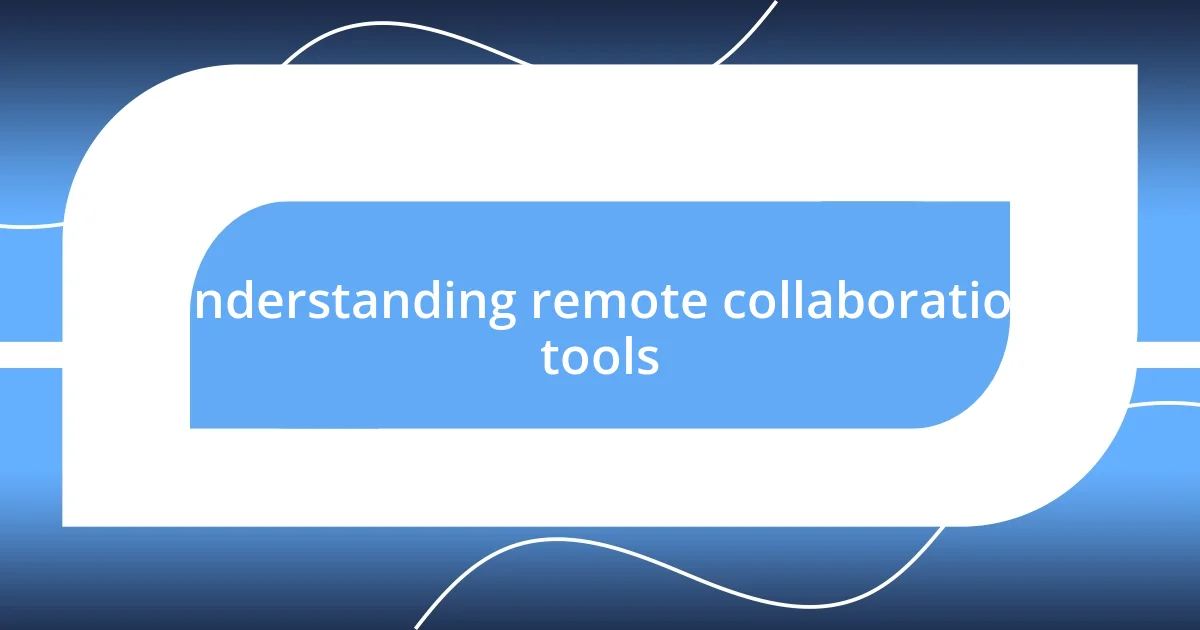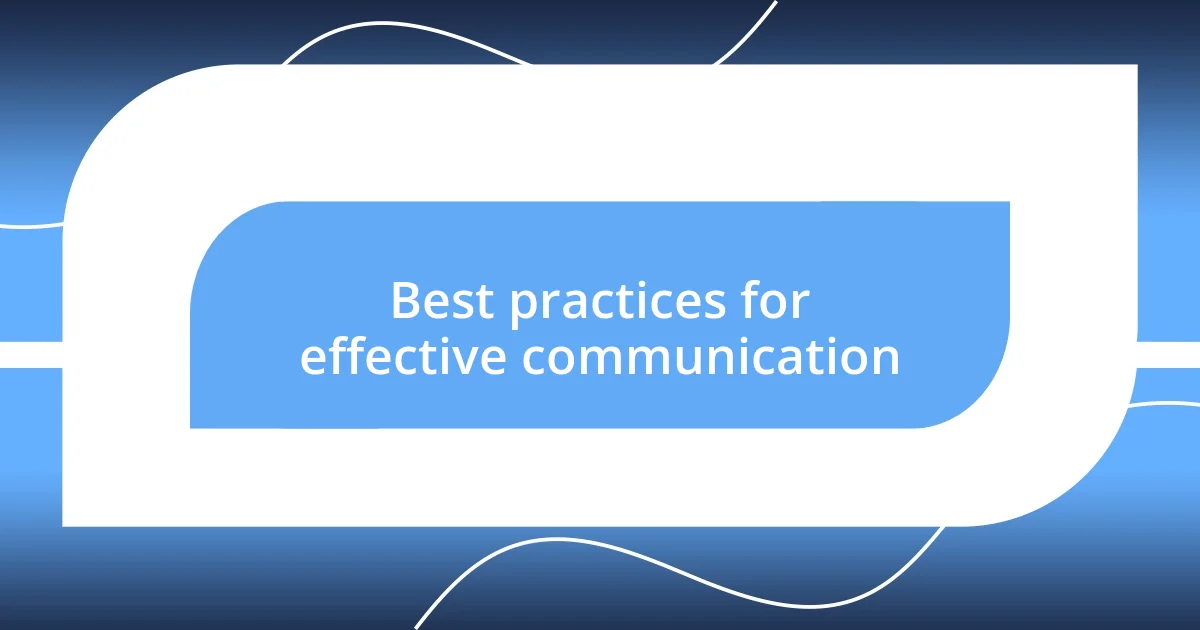Key takeaways:
- Transitioning from basic email communication to real-time tools like Slack and Microsoft Teams enhances team interaction and fosters accountability.
- Choosing the right collaboration tool requires hands-on testing and prioritizing team needs, which can significantly impact engagement and productivity.
- Establishing a culture of trust, clarifying communication preferences, and continuously evaluating tool performance are essential for overcoming common remote collaboration challenges.

Understanding remote collaboration tools
Remote collaboration tools have revolutionized the way teams interact, especially since I’ve experienced their evolution firsthand. I remember the early days when we relied heavily on basic email threads, often leading to confusion and miscommunication. Have you ever felt overwhelmed by the sheer volume of emails flying back and forth? It’s a relief that tools like Slack and Microsoft Teams allow for real-time communication, providing a space where conversations happen seamlessly.
As I delved deeper into the world of remote tools, I discovered how platforms like Trello and Asana transformed project management for my team. I vividly recall the satisfaction of visually tracking our progress on a shared board. Isn’t it empowering to see tasks move from “in progress” to “completed”? These tools foster accountability and transparency, making it easier to collaborate regardless of physical distance.
Additionally, I’ve come to appreciate how video conferencing tools, like Zoom, have bridged the emotional gap that can occur when working remotely. There’s something about seeing a colleague’s face that can’t be replicated through chat alone. Have you ever noticed how quickly a video call can lift the mood of a team meeting? It’s those moments of connection that remind us we’re all in this together, striving toward the same goals despite being miles apart.

Choosing the right collaboration tool
Choosing the right collaboration tool can feel like a daunting task, especially when so many options are available. I remember grappling with this decision for my team, weighing features like ease of use against essential functionality. A tool that seemed perfect on paper turned out to be frustrating in practice, reinforcing my belief that hands-on testing is crucial—never underestimate the power of trial and error!
As I began to evaluate various platforms, I found it helpful to create a list of priorities based on my team’s specific needs. For example, we had to consider whether we needed extensive project management features or if streamlined communication was our top priority. I’ll never forget the moment we switched to Notion; it aligned perfectly with our workflow, and suddenly, everything felt more organized. It was a game-changer!
When you’re in the trenches of remote work, the right collaboration tool can make a world of difference. I often ask myself: does the tool promote engagement and interaction among team members? I’ve seen firsthand how the wrong choice can lead to disengagement, while the right one can truly invigorate a group, igniting passion and creativity. It’s exciting to think that with a little exploration, you can unlock your team’s potential!
| Tool | Best For |
|---|---|
| Slack | Real-time messaging |
| Trello | Visual task management |

Setting up your collaboration environment
Setting up your collaboration environment is about creating a space that fosters productivity and connection. From my experience, I’ve learned that the physical and digital spaces we inhabit can significantly impact our teamwork. For instance, I tried adjusting my workspace layout to enhance communication; placing my computer screen at eye level while ensuring my desk felt inviting made all the difference. It encouraged me to engage more deeply during video calls, as I felt more comfortable showing off my space, even a bit of personality!
In addition to optimizing your workspace, the right tools play a vital role in setting up an effective collaboration environment. Here’s a checklist that I’ve found helpful:
- Ensure reliable internet connectivity: A stable connection is crucial for seamless communication.
- Utilize noise-canceling headphones: They help maintain focus during calls and block out distractions.
- Invest in ergonomic furniture: Comfort can drastically improve your focus and productivity over long working hours.
- Create a shared digital space: Use tools like Google Drive or Dropbox to keep important documents easily accessible.
- Leverage cloud storage solutions: This not only secures your data but also makes collaboration easier across different devices.
Reflecting on these elements, I’m constantly re-evaluating and adjusting my environment to get the most out of my remote collaboration experiences. Sometimes, a small tweak can have a profound effect on both my productivity and mood. Have you experimented with your setup lately?

Best practices for effective communication
Effective communication is the lifeblood of remote collaboration. I’ve discovered that regularly checking in with team members through brief video calls can bridge the gap that text messages often create. One experience that stands out was when I initiated weekly catch-ups; the energy in our group shifted—suddenly, we felt more connected and aligned in our goals.
Another practice that has served me well is clarifying expectations upfront. When I started using a shared document to outline meeting objectives and action items, I noticed a significant drop in confusion. It’s amazing how clarity can prevent misunderstandings and keep everyone on the same page—have you ever found yourself puzzled after a meeting? That’s the kind of frustration I was eager to eliminate.
Lastly, embracing feedback has transformed my approach to communication. Initially, I hesitated to ask for input on my contributions, fearing it might be perceived as weakness. However, when I opened up channels for constructive criticism, it not only improved my work but also fostered a culture where everyone felt valued. Who wouldn’t want to be part of a team where openness and growth are encouraged?

Managing time zones and scheduling
Managing time zones is undoubtedly one of the most challenging aspects of remote collaboration. I recall a project where my team was spread across three continents; it felt like a logistical puzzle. I had to become adept at using tools like World Time Buddy to coordinate our meetings. Trust me, double-checking time conversions saved me from some really awkward situations. Have you experienced the difficulty of timing a call just right to avoid waking someone up at an ungodly hour? It’s an almost universal struggle that demands careful planning.
Scheduling meetings can sometimes feel like an intricate dance—one wrong move and everything collapses. I’ve learned the importance of using scheduling tools like Calendly, which allow team members to book time slots that work for them without the back-and-forth emails. This streamlined our process, and I was relieved to see how much more productive we became. Have you ever caught yourself scrolling through endless email chains just to find a mutually agreeable time? I used to dread that, but now, it feels liberating to see everyone’s availability laid out clearly.
Lastly, it’s crucial to establish a norm around flexible working hours. When I shared my “core hours” with my colleagues, it allowed us to have overlap time for real-time collaboration while still respecting personal boundaries. I felt like a weight lifted off my shoulders when I didn’t have to sacrifice my evenings just for a meeting. Have you set similar boundaries for yourself? Finding that sweet spot where everyone feels comfortable can promote a healthier work-life balance.

Overcoming common collaboration challenges
While remote collaboration can spark a range of challenges, I’ve found that fostering a culture of trust is vital in overcoming them. For instance, in a team where accountability was lacking, I took the initiative to share progress updates regularly. Let me tell you, that small change led to a noticeable shift in dynamics; suddenly, everyone felt a greater sense of responsibility. Can you relate to the experience of wanting to contribute but feeling unsure of where you stand?
Another challenge I encountered was the difficulty in conveying emotions through screens. I remember a moment of miscommunication during a crucial project when my intention was lost in translation. To tackle this, I decided to layer my messages with emojis or GIFs, which added a touch of warmth to our exchanges. Have you ever felt like your enthusiasm fell flat in an email? Sometimes, it takes a little creativity to ensure our excitement comes through, even when we’re not face-to-face.
Finally, managing differing communication styles can feel like a balancing act. I once worked with a colleague who preferred detailed reports, while another thrived on quick chats. I initiated a “communication preferences” session, allowing each team member to share their preferred methods. In doing so, we created a roadmap that minimized friction and maximized engagement. Isn’t it refreshing to tailor your approach to meet everyone’s needs? I truly believe that understanding individual styles can lead to a more cohesive and productive team.

Evaluating collaboration tools performance
When it comes to evaluating collaboration tools, I’ve learned that performance metrics are essential for determining effectiveness. One project I spearheaded involved several tools, and I made it a point to assess their usage through analytics like user engagement and task completion rates. You wouldn’t believe the difference it made! I realized how crucial it is to measure both quantitative data and qualitative feedback from my team to refine our processes. Have you ever noticed how a tool that seems fantastic on the surface can fall short in actual application?
I remember trying out a popular project management tool in one of my teams, only to find it overwhelming for some members. I decided to conduct a short survey to gather input directly from my colleagues. The responses were eye-opening! Engaging the team in this way helped pinpoint specific pain points, which allowed us to make more informed choices when selecting tools. It’s fascinating how a simple evaluation exercise can lead to deep insights, isn’t it?
Furthermore, I can’t stress enough the importance of continuous evaluation. After implementing a new tool, I made it a habit to review its performance on a quarterly basis. I would gather everyone for a feedback session to discuss what was working and what was not. This not only kept us aligned but also encouraged a culture of open communication. Have you ever tried incorporating regular evaluations into your routine? It transformed our understanding of the tools we used, paving the way for improved collaboration and satisfaction across the board.














